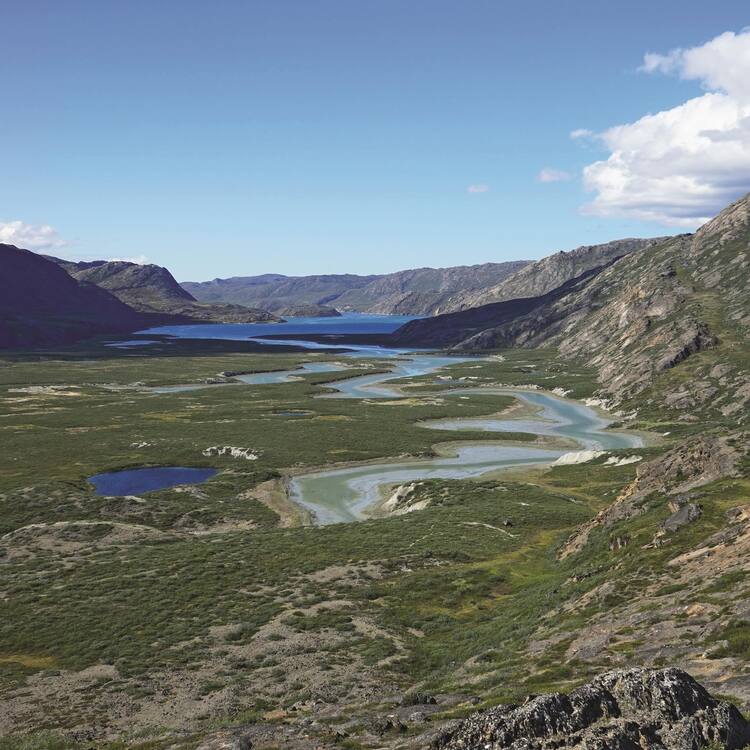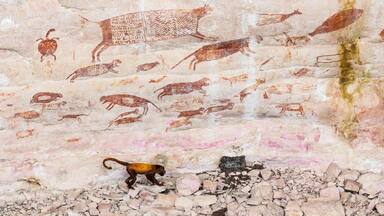Aasivissuit – Nipisat. Inuit Hunting Ground between Ice and Sea
Aasivissuit – Nipisat. Inuit Hunting Ground between Ice and Sea
Located inside the Arctic Circle in the central part of West Greenland, the property contains the remains of 4,200 years of human history. It is a cultural landscape which bears witness to its creators’ hunting of land and sea animals, seasonal migrations and a rich and well-preserved tangible and intangible cultural heritage linked to climate, navigation and medicine. The features of the property include large winter houses and evidence of caribou hunting, as well as archaeological sites from Paleo-Inuit and Inuit cultures. The cultural landscape includes seven key localities, from Nipisat in the west to Aasivissuit, near the ice cap in the east. It bears testimony to the resilience of the human cultures of the region and their traditions of seasonal migration.
Description is available under license CC-BY-SA IGO 3.0
Aasivissuit-Nipisat. Terres de chasse inuites entre mer et glace
Se trouvant au nord du cercle arctique, dans la partie centrale de l’ouest du Groenland, le bien contient des vestiges de 4 200 ans d’histoire humaine. Les populations ont façonné un paysage culturel fondé sur la chasse aux animaux marins et terrestres, les modes saisonniers de migration et un patrimoine culturel matériel et immatériel riche et préservé, lié notamment au climat, à la navigation ou à la médecine. Parmi les caractéristiques du bien figurent de grandes maisons d’hiver et des traces de chasse au caribou ainsi que des gisements archéologiques des cultures paléo-inuite et inuite. Ce paysage culturel est présenté au travers de sept localités importantes, de Nipisat à l’ouest à Aasivissuit près de la calotte glacière, à l’est. Il démontre la résilience des cultures humaines de cette région et leurs traditions de migrations saisonnières.
Description is available under license CC-BY-SA IGO 3.0
أراضي
يوجد هذا الموقع شمال القطب الشمالي وتحديداً في الجزء الأوسط غرب جرينلاند، ويحتوي على آثار تجسّد 4200 عاماً من تاريخ البشرية. إذ ساهم السكان الذين تعاقبوا على المكان في تشكيل منظر ثقافي قائم على صيد الحيوانات البحرية والبرية، وأنماط الهجرة الموسمية وتراثاً ثقافيّاً غير مادياً غنياً وبحالة جيدة، ويرتبط على نحو خاص بالمناخ والملاحة والطب. ويتميز الموقع بمجموعة من العناصر من بينها مثلاً المنازل الشتوية الكبيرة وآثار لصيد الأيّل، بالإضافة إلى الرواسب الأثرية تعود لثقافة الإنويت والثقافة السابقة للإنويت. ويمتد هذا المنظر الثقافي عبر سبعة مجتمعات محلية هامة من نيبيسات غرباً حتى أيسيفيسوت بالقرب من الغطاء الجليدي شرقاً. ويًبرز الموقع التعاقب المستمر للثقافات البشريّة في هذه المنطقة وتقاليد هجراتهم الموسمية.
source: UNESCO/CPE
Description is available under license CC-BY-SA IGO 3.0
冰与海之间的因纽特人狩猎场阿斯维斯尤特–尼皮萨特
此处遗产地位于西格陵兰中部的北极圈内,这里有着4200年的人类历史遗迹。该文化景观见证其创造者对陆地和海洋动物的捕猎、季节性的迁徙,以及保存完好的气候、航海和医学方面丰富的物质和非物质文化遗产。该遗产地的特征包括大型冬季营房、驯鹿狩猎遗迹,以及古代因纽特人和因纽特文化的考古遗址。其文化景观包括7个主要地点,从西部的Nipisat到东部冰盖附近的Aasivissuit。它反映了该地区人类文化的复原力及季节性迁移的传统。
source: UNESCO/CPE
Description is available under license CC-BY-SA IGO 3.0
Aasivissuit-Nipisat. Инуитские охотничьи угодья между морем и льдами
Расположенный к северу от полярного круга в центральной части Западной Гренландии, этот объект сохраняет следы 4200 лет человеческой истории. Коренные народы этого региона сформировали культурный ландшафт, в основе которого – охота на морских и наземных животных, сезонная миграция и сохранившееся богатое нематериальное культурное наследие. Они связаны с особенностями климата, навигацией и медициной. Среди характерных черт объекта - большие зимние дома и следы охоты на северных оленей карибу, а также залежи археологических артефактов, свидетельствующих о культуре палео-инуитов и современных инуитов. Этот культурный ландшафт сформировался и существует в семи важных локализациях - от острова Ниписат на западе до охотничьих угодий Осивиссуит на востоке, вблизи ледяной шапки. Объект Aasivissuit-Nipisat демонстрирует жизнеспособность человеческих культур в этом регионе и их традиции сезонной миграции.
source: UNESCO/CPE
Description is available under license CC-BY-SA IGO 3.0
Aasivissuit-Nipisat – Cotos de caza marítimos y glaciares de los inuits
source: UNESCO/CPE
Description is available under license CC-BY-SA IGO 3.0
Outstanding Universal Value
Brief synthesis
Climate and topography in West Greenland along a vast west-to-east transect from the ocean and fjords to the ice sheet contains evidence of 4200 years of human history. Fisher-hunter-gatherer cultures have created an organically evolved and continuing cultural landscape based on hunting of land and sea animals, seasonal migrations and settlement patterns, and a rich and well-preserved material and intangible cultural heritage. Large communal winter houses and evidence of communal hunting of caribou via hides and drive systems are distinctive characteristics, along with archaeological sites from the Saqqaq (2500-700 BC), Dorset (800 BC-1 AD), Thule Inuit (from the 13th century) and colonial periods (from the 18th century). The cultural landscape is presented through the histories and landscapes of seven key localities from Nipisat in the west, to Aasivissuit, near the ice cap, in the east. The attributes of the property include buildings, structures, archaeological sites and artefacts associated with the history of the human occupation of the landscape; the landforms and ecosystems of the ice cap, fjords, lakes; natural resources, such as caribou, and other plant and animal species that support the hunting and fishing cultural practices; and the Inuit intangible cultural heritage and traditional knowledge of the environment, weather, navigation, shelter, foods and medicines.
Criterion (v): Aasivisuit-Nipisat and the transect of environments it contains demonstrates the resilience of the human cultures of this region and their traditions of seasonal migration. The abundant evidence of culture-nature interactions over several millennia, intact and dynamic natural landscape, intangible cultural heritage and continuing hunting and seasonal movements by Inuit people and other attributes combine in this distinctive cultural landscape. This is demonstrated through the continuing uses of the west/east routes, the rich archaeological record of Palaeo-Inuit and Inuit cultures, and the camps and hunting elements that enabled hunting-fishing-gathering peoples to live in the Arctic region.
Integrity
The integrity of the cultural landscape is based on the inclusion of areas of ocean, fjords, islands, inland and ice cap that can demonstrate the historical and present-day migrations and seasonal patterns of hunting and fishing. The property contains a sufficient sequence of environments, archaeological sites and settlements to demonstrate the cultural histories and significant intangible cultural heritage of this part of Greenland, including the settlements and the seasonal hunting, fishing and gathering activities of the present-day communities. Seven key localities have been specifically described, although attributes of Outstanding Universal Value occur throughout the property, and are potentially vulnerable due to pressures from climate change.
Authenticity
The authenticity of the cultural landscape is based on the inclusion of a complete landscape and seascape, the interdependence of the fishing-hunting-gathering lifeways with the natural processes and resources, and the tangible evidence of the hunting and settlement practices and patterns for 4200 years. The transect of environments from the sea, fjords, interior and the ice cap has been used by each phase of human culture for fishing and hunting of marine animals and caribou, according to seasonal movements. Archaeological sites and artefacts demonstrating a good state of preservation, and the ruins of historical structures bear witness to the history and traditions of land and sea uses in the Arctic. The continuity of some of the seasonal hunting and migration practices, and the associated Inuit intangible cultural heritage and traditional knowledge contribute to the authenticity of the cultural landscape.
Protection and management requirements
The government of Greenland is responsible for decisions about land and sea use, and protection of the cultural landscape is subject to an Executive Order of the Government of Greenland (Naalakkersuisut) which came into force on 1 February 2018. This provides the basis of the legal protection for the property, including the formal establishment of the boundary, and provisions for access, protection, management, monitoring and uses. The regulations to the Executive Order and the Mineral Resources Act prevent the granting of licenses for mining prospecting or exploration. Further legal protection of the cultural landscape is provided by Greenland’s Heritage Protection Act, Museum Act, and the Planning Act. The Greenland National Museum and Archives is responsible for decisions within the Heritage Protection Act. The Municipal Plan for the Qeqqata Municipality covers relevant planning regulations for the property, such as for local tourism, infrastructures, zoning for wilderness, summer houses, recreation and trophy hunting and matters concerning the settlement at Sarfannguit.
Protection of the landscape and natural attributes is provided by the Act on Environmental Protection and the Ramsar Executive Order (2016). There are regulations for catch quotas for fish, sea mammals and inland hunting species (such as caribou). There is a need to integrate the Ramsar criteria for the Eqalummiut Nunaat and Nassuttuup Nunaa area into the overall management plan for the property.
Because there is no buffer zone for this property, there are continuing needs to strengthen mechanisms for assessment and protection of the property from off-site activities, including the potential hydrological and geological impacts of future mining proposals, transportation infrastructure and wind turbine installations. Greater attention and detailed planning is needed for the area’s future tourism management, including monitoring of the social and physical impacts of tourism.
The Management Plan (January 2017) provides a sound framework for decision-making, together with the operation of the 10-member World Heritage Steering Committee. The Management Plan outlines responsibilities of the Danish Agency for Culture and Palaces, the Government of Greenland, and the Qeqqata Municipality. The availability of the resources for implementation of the management system should be confirmed, including the timeline, expertise and financial resources to engage appropriately skilled site manager and rangers, and to develop the tourism and interpretation plans. Continuing documentation of cultural practices and intangible culture heritage, and regular and cyclical monitoring and maintenance are needed as a priority.


